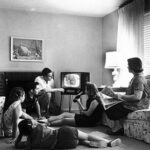What is the legacy of Kathryn Kuhlman? Well that depends on who you ask. Being widely known thanks to her national television show, the whole country knew of Kuhlman'”they just didn’t know what to think of her. Many praise Kuhlman as a pioneer who allowed our generation to know the Holy Spirit in fellowship and love; to her she was the “woman who believed in miracles” and had an anointing from God. On the other hand, Kuhlman has been criticized for her theology'”from how people were “slayed in the Spirit,” to her relation to the Holy Spirit, to her openness to Catholics; Kuhlman was criticized for her character'”her marriage to a divorcee, her use of what was essentially an escort, and her extravagant spending habits; Kuhlman was criticized for her claims'”some believed she truly had no anointing at all, but was simply a fraud.
Born May 9, 1907 in Concordia Missouri, Kuhlman was never what might be called “pretty”‘”with red hair and gangly boyish features. Even then she demonstrated self-reliance, independence, and a need to do things her way, which carried with her through her life. Kuhlman grew up attending a Methodist church with her mother, but at the age of fourteen experienced a call directly from the Holy Spirit, separate from the understanding or direction of those at the church. Shortly thereafter, Kuhlman dropped everything to travel with her sister and brother-in-law in the ministry. Her sister and brother-in-law were financially strapped and soon left Kuhlman and another fellow minister, Helen Gulliford, to fend for themselves in Boise, Idaho. It was with Gulliford, preaching in an old pool hall that Kuhlman’s ministry took off.
The two lived in poverty and worked hard to support their ministry activities. They had to clean the pool hall themselves. When Kuhlman broke her foot, she continued to preach. Their accommodations varied from a scrubbed out turkey house to cold, unheated guesthouses.
Kuhlman and Gulliford moved to Denver in 1933 and had their business manager prepare a place for their preaching as though they had the unlimited resources of God behind their ministry. He rented an old Montgomery Ward Company warehouse, which turned out not to be big enough to accommodate the large crowds that flocked to the Kathryn Kuhlman ministry over the following five months. By 1935, Kuhlman’s ministry had a permanent building'”the Denver Revival Tabernacle. Services went on every night of the week except Mondays. It was a thriving Church'”Sunday school, buses to bring people to church, outreaches to prisons and nursing homes, a radio program called “Smiling Through.”
However, it all came crashing down in 1938 when Kathryn Kuhlman announced to her congregation that she would be joining ministries with Burroughs A Waltrip. An extremely handsome man with a ministry based out of Mason City, Waltrip was also a divorcee who had left his wife and two sons to be with Kuhlman. His motives are questionable, being that in the beginning he claimed that his wife had actually left him. Through the truth did surface, Kuhlman chose to believe what gave her what she wanted'”Waltrip. Through heavy opposition from Helen, the Denver Tabernacle staff and congregation, and even Waltrip’s own mother, Kuhlman continued on to marriage. She knew it was wrong and fainted during the ceremony, yet still stayed with Waltrip for the next 6 years. She left him in 1944, as the conviction of the Holy Spirit upon her life became too heavy to bear any longer.
Though she struggled for years to begin her ministry again because her past continued to surface and haunt her, Kuhlman eventually started to draw crowds again. Beginning in 1947 people began to be healed simply listening to her preach on the Holy Spirit. She rented an old roller skating rink and called the church Faith Temple. Kuhlman was then lead to move to Pittsburgh, where she preached at Carnegie Hall.
By 1950, Kuhlman’s ministry had a global reach. She established the Kathryn Kuhlman Foundation to build more than twenty churches in mission fields around the world. Her healing ministry was well known. Her messages were broadcast on short-wave radio around the country and the world. She had a weekly half hour television show for the last 8 years of her life.
The Shrine Auditorium housed her ministry for the last 10 years, where thousands were ministered to and hundreds healed. She traveled extensively in the end, speaking at many conferences and connecting with many denominations. She was a true ecumenical.
Still yet, Kuhlman stirs controversy. Theologically she is questioned. She never permitted people to speak tongues in her services as it disturbed others there. However, the way in which people became “slayed” in the Spirit, by the laying on of hands and falling backwards into the arms of the “catcher” was completely new, originating with her ministry. Some point out that though revival is always characterized by people laying prostrate on the ground under the weight of the Holy Spirit, the particular practice as seen with Kuhlman was completely foreign to those who witnessed it happening to people in her meetings. Some simply question her focus on the Holy Spirit and its how she portrayed it as being such a separate entity from Jesus.
Additionally, she has been criticized for her ecumenical ways extending so openly to Catholics. Before revival meetings, she would ask that a Catholic Mass pray for the meeting’s success. She would insist that priests and nuns be on the platform with her and in full cleric attire during the services. To many Protestants this was sacrilege. The protestant that published this criticism pointed out especially the Catholic belief in transubstantiation during the Mass, and the Protestants who died opposing it. This criticism seems to be based more on the ingrained distrust and distaste between Catholics and Protestants that has existed since the wars of the Reformation rather than true theological or practical reasoning.
Kuhlman’s legacy is also plagued by criticisms of her character. It seems she had a weakness for men that lead her away from God. As mentioned earlier, she married a divorcee who had abandoned his family for her. She participated in his sin by serving as his reward. She even claimed that “God had revealed a new plan” for her. Most people generally agreed this was not to be of God. Kuhlman later admitted it herself. So how could someone walking in such communion with the Spirit be so mislead?
Kuhlman also faced much criticism for her relationship with the very attractive Dino Kartsonakis. He was essentially her young male escort, who took her to dinner, sat with her on long plane rides, hailed taxis, paid porters, etc. The staff working under Kuhlman called him a gigolo.
Additionally Kuhlman’s character was attacked for her taste and indulgence in expensive and extravagant living. She regularly wore very expensive gowns. She loved fine dining, fancy accommodations, and first class travel.
Even her anointing was questioned. She was a woman who believed in miracles and seemed to be anointed to work them. Countless hundreds came forward even on national television to speak of how they had been healed while sitting and listening to Kuhlman preach. Time Magazine published an article on Kuhlman in 1970 with anecdotes of people who had been healed. Yet, at the bottom of the article, there was a claim that read: “The staff spends little time verifying healings because Kathryn has no doubt that they are accomplished. But in some remarkable cases, — they attempt to document them carefully.” One carefully documented case was that of a 12 year old who was healed of rheumatoid arthritis, rheumatic fever, and a tumor on the spine. On the other hand, a book published by Dr. William Nolan in the early 1970s reported that the doctor had attended one of Kuhlman’s meetings and noted the names and healings of 25 who were healed during the service. Yet, in following up, he discovered that one woman supposedly having been cured of lung cancer actually had Hodgkin’s Disease, which was unaffected. One woman with spinal cancer took off her brace during the service and ran across the stage as Kuhlman had demanded; the next day her backbone collapsed and she died four months later. Nolan concluded that no one with an organic disease had been healed of the 25 he noted. Reports go both ways'”was she anointed? Did she fool so many?
The question ultimately lies in the hearts of each individual. Those who experienced her healing directly can do nothing but believe because of their own personal experience. Thousands still put their faith in her. Others are much more skeptical. Science wins out for some when they test the miraculous through the scientific method. Even those who may not question the miracles question how God could use such a weak and broken person, prone to fall for men and luxury. How could one so open to Catholics also usher in the quintessential charismatic “slaying” in the Spirit? She was a woman with many weaknesses and chose radical ecumenicalism, both of which invited criticism. Yet she knew'”it was God. He was faithful, even where she failed.
Sources: Liardon, Roberts (1996) “God’s Generals: Why They Succeeded and Why Some Failed.” Tulsa: Albury Pub.
Additional Information: Roberts Liardon. “Kathryn Kuhlman,” God’s Generals: Christian History.



